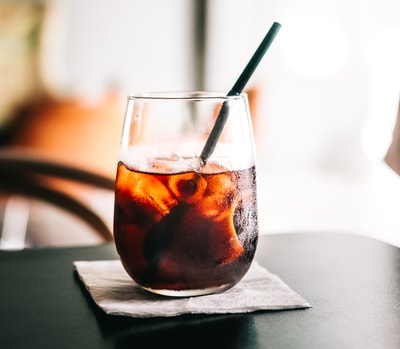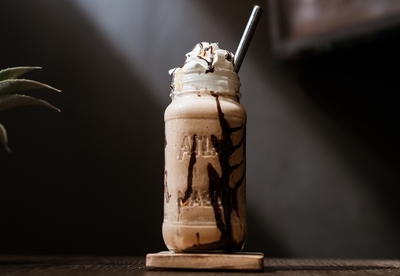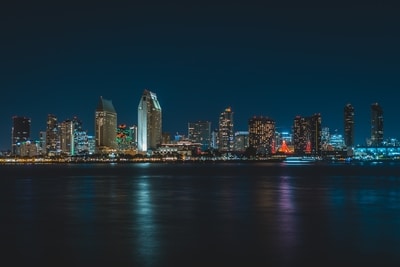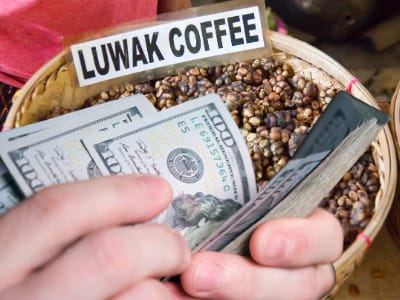5 Delicious Cold Brew Coffee Recipes (& FAQ Guide)
Cold brew isn’t just an excellent drink to enjoy in summer but a great way to make bitter-free concentrate that will keep for up to a week in the fridge. In this guide, I’m going to show you five recipes and answer all your cold brew questions.
How to make cold brew
#1: Quick and easy cold brew recipe
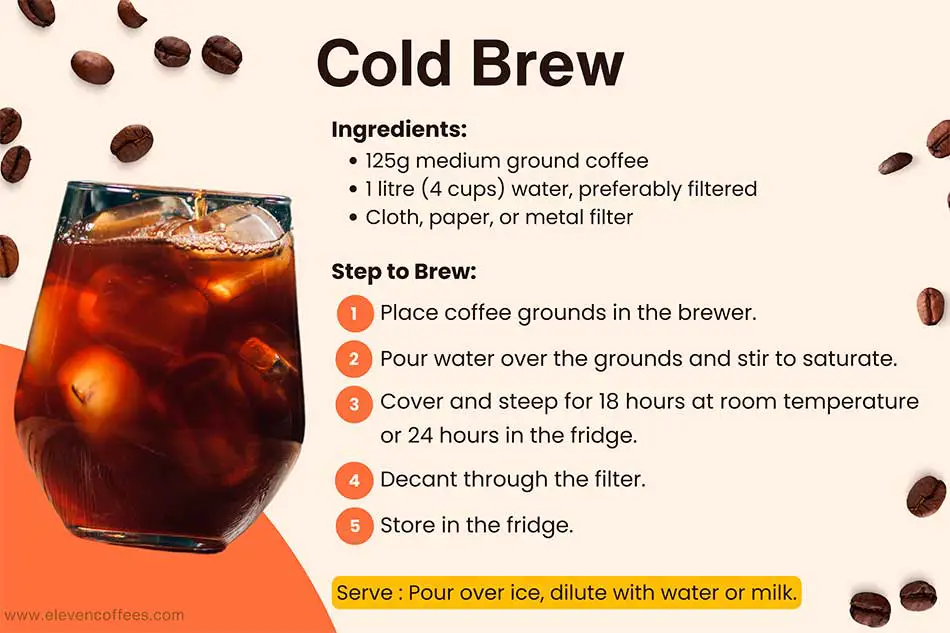
This is a quick and easy recipe to get you started. Use a French press, a Mason jar, or a large Tupperware container to brew your coffee.
- 125g coffee, medium ground
- 1 litre (4 cups) water, preferably filtered
- Some sort of filter: cloth, paper or metal
- Place your coffee into your brewer of choice and pour over the water. Give it a thorough stir to ensure all the coffee is completely saturated.
- Place on the lid and leave for 18 hours at room temperature or 24 hours in the frige.
- Decant your cold brew through your filter of choice.
- Refrigerate.
- As and when you want a cup, pour over lots of ice to chill and dilute. Add milk if you like.
That’s how simple it is to make great tasting cold brew coffee.
The coffee to water ratio used was 1:8. Feel free to scale up or down. I recommend making at least a litre as cold brew coffee will happily keep for up to a week in the fridge. It’s also very more-ish, so you’ll definitely want to make lots at a time.
If you’re using a paper filter, make sure to rinse using boiling water before filtering your coffee so as not to impart any papery flavours into your cold brew.
#2: Hot bloom cold brew recipe
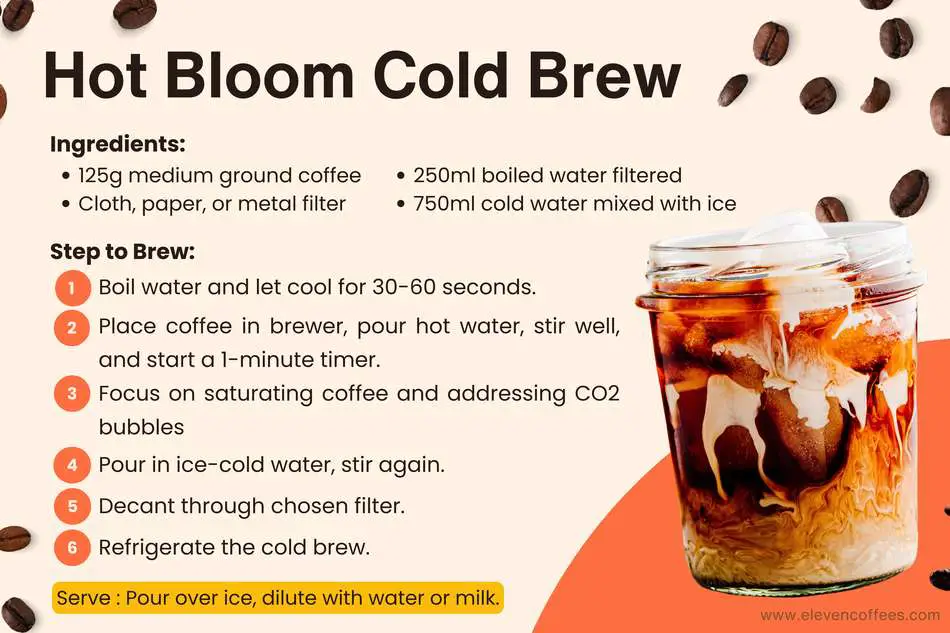
The second recipe has an extra step but is well worth the trouble. You start the coffee off with a small amount of hot water. Doing so creates a cold brew which is a lot more complex in flavour.
- 125g coffee, medium ground
- 250ml (1 cup) boiled water, preferably filtered
- 750ml (3 cups) cold water mixed with ice
- Some sort of filter: cloth, paper or metal
- Place your coffee in your brewer of choice. Bring 250ml of water to the boil and leave to cool for 30 – 60 seconds.
- Pour in the hot water and start your timer for one minute. Give the ground coffee a good stir to ensure everything is saturated, concentrating more on the areas where you see CO2 bubbles appearing.
- After one minute, pour in 750ml of the ice-cold water and give it another stir.
- Leave for 18 hours at room temperature or 24 hours in the fridge.
- Decant your cold brew through your filter of choice.
- Refrigerate.
- As and when you want a glass, pour over lots of ice to chill and dilute. Add milk if you like.
Again this recipe uses a coffee to water ratio of 1:8. The hot water used to bloom the coffee was at a ratio of 1:2.
Ensure that you prepare your ice/water mix before starting your brew as you want to stop the hot bloom extraction immediately after one minute. The total volume of cold water mixed with ice should be 750ml.
You can vary the time you leave the coffee to steep. Steeping for 12 hours will give you a lighter, more acidic brew whereas 24 hours will result in a heavier, more intense brew.
Feel free to play with the coffee to water ratios as well. Bare in mind that you may want to make it a little stronger if you like to enjoy your cold brew with milk.
#3: Two minute cold brew recipe
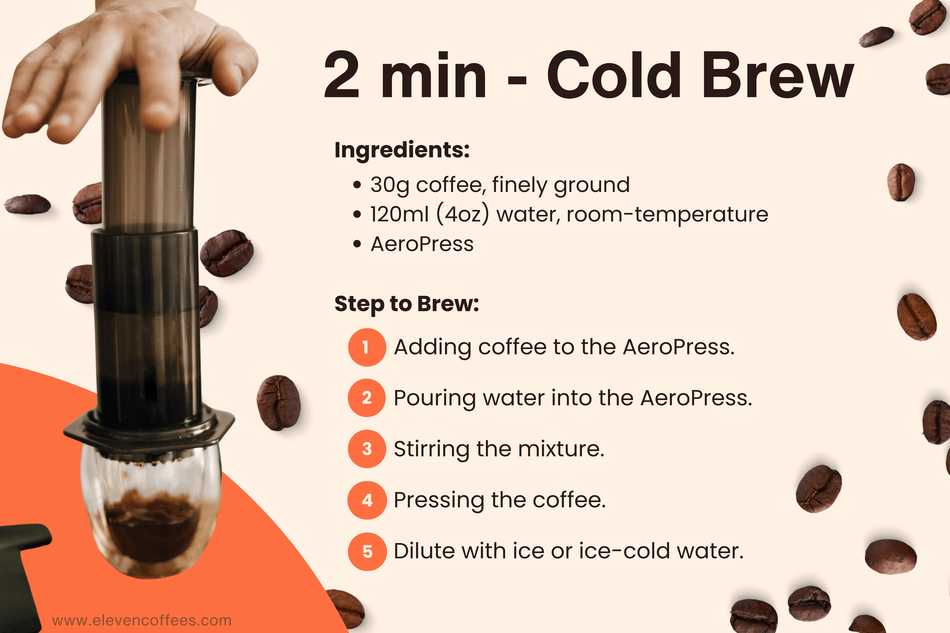
Two minute AeroPress cold brew. Yes, that’s right, just two minutes! This is great if you want a cup of cold brew in a hurry.
- 30g coffee, finely ground
- 120ml (4oz) water, room-temperature
- Add the coffee to your AeroPress
- Add in your water and stir vigorously for 60 seconds.
- Press.
- Dilute with ice or ice-cold water.
The key to the two minute cold brew is in the stirring as it dramatically speeds up the extraction process.
If you’re brewing with the regular paper AeroPress filters, you can use the AeroPress the traditional way round as the low quantity of water combined with the high quantity of finely ground coffee will not allow significant amounts of water to pass through.
However, if you’re using a metal filter, you’ll need to turn the AeroPress upside down (inverted) as the larger holes in the metal filter will definitely allow the water to pass through.
#4: Nitro cold brew recipe
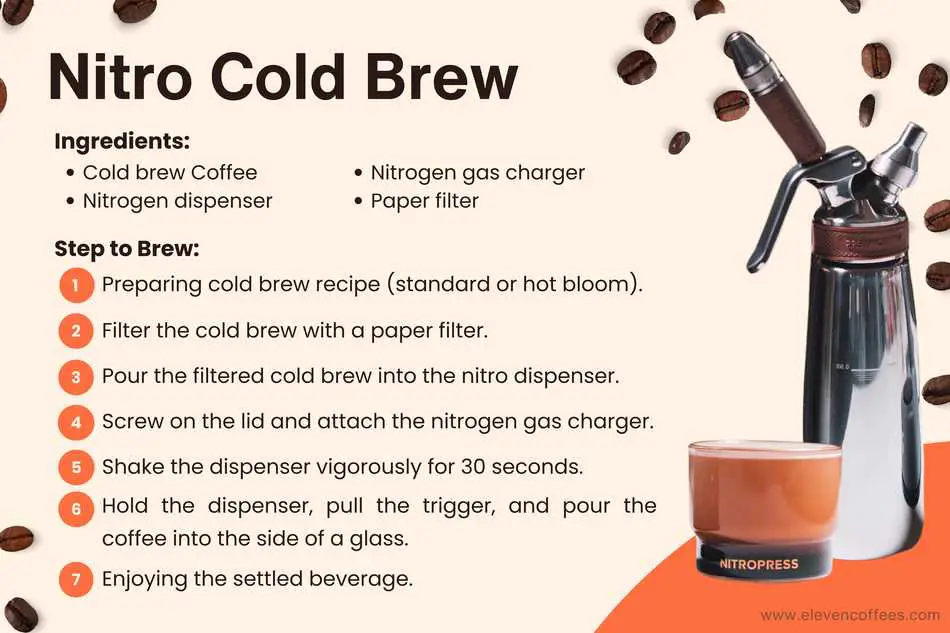
Nitro cold brew is cold brew coffee that’s infused with nitrogen. It’s smoother and richer than standard cold brew and has a pleasant sweetness that the nitrogen imparts. Nitro cold brew is delicious and will certainly impress friends and family.
- Proceed as for recipe #1 or #2, whichever you like best. Filter your cold brew with a paper filter to avoid clogging your nitro dispenser.
- Fill your nitro dispenser to the max-line with your cold brew coffee.
- Screw on the lid and attach the gas charger.
- Shake vigorously for 30 seconds.
- Holding the dispenser upside-down: pull on the trigger and pour into the side of the glass.
- Take a moment to enjoy watching how the beverage settles. Enjoy.
#5: Cold brew extra concentrate recipe
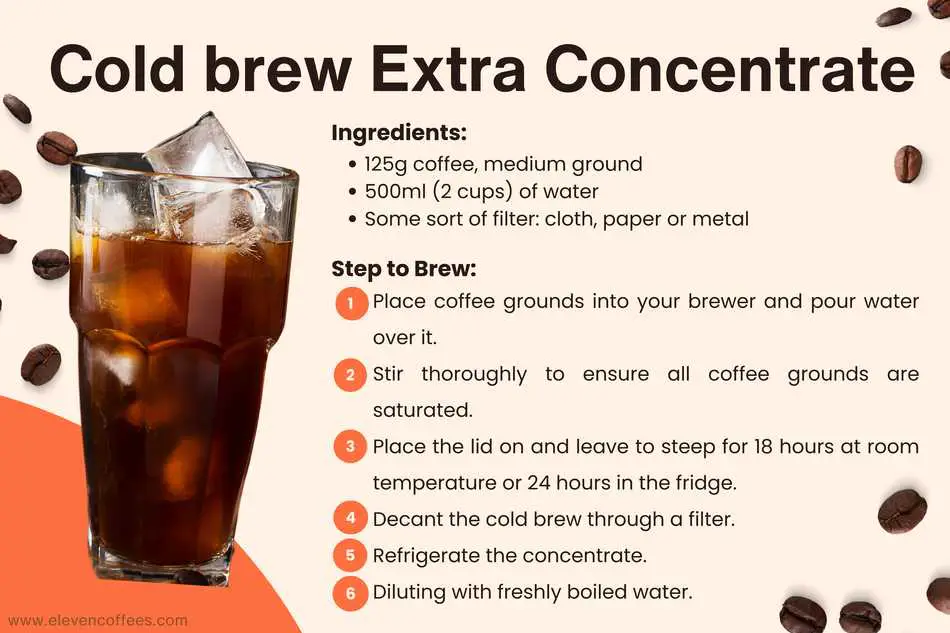
Another great reason for making cold brew is as a base for making hot coffee in an instant. Heating hot coffee that has gone cold in the microwave doesn’t taste good. A great workaround is to make an extra-strong cold brew concentrate that you can dilute as and when with freshly boiled water. It’s quicker and tastier than instant.
- 125g coffee, medium ground
- 500ml (2 cups) of water
- Some sort of filter: cloth, paper or metal
- Place your coffee into your brewer of choice and pour over the water. Give it a thorough stir to ensure all the coffee is completely saturated.
- Place on the lid and leave for 18 hours at room temperature or 24 hours in the fridge.
- Decant your cold brew through a filter.
- Refrigerate.
- As and when you want a cup, dilute at a ratio of cold brew to freshly boiled water at 1:1 – 1:2. Use slightly less if adding milk.
This recipe uses a coffee to water ratio of 1:4, which is very strong. It’s necessary to make it extra concentrated so as to allow for a heavy dilution.
A lot of people love the smell of coffee but can’t stand the bitterness. Also, a lot of people have a sensitivity to acid. Cold brew produces coffee which is bitter-free and slightly lower in acidity.
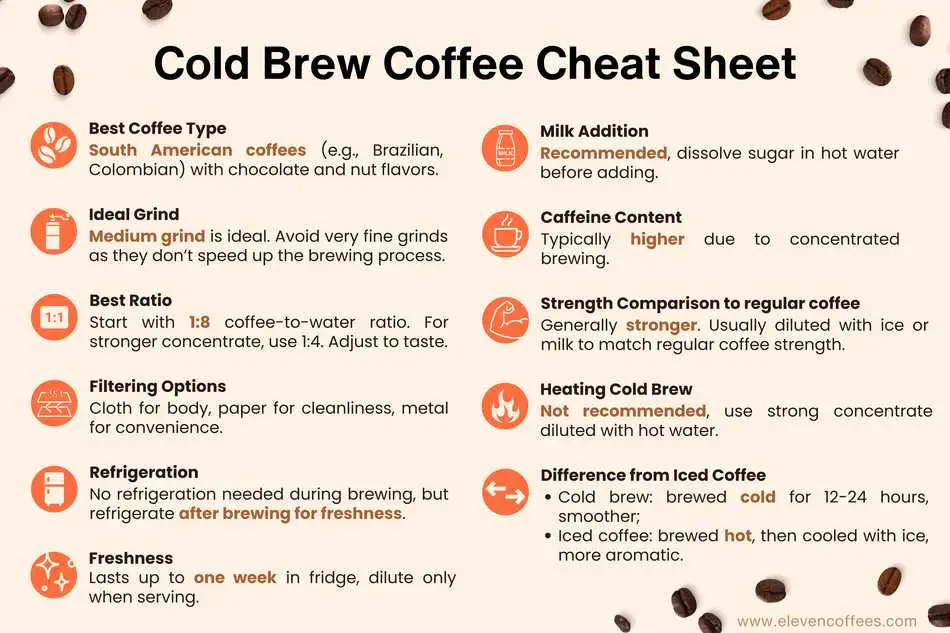
What type of coffee is best for cold brew?
A good choice for cold brew is a South American coffee such as a Brazilian or Colombian. Cold brew produces a muted and more rounded-tasting coffee that lends itself to big and bold coffees with flavours such as chocolate and nuts.
As such, it’s recommended not to use coffees with funky flavours such as those from Africa, namely Ethiopian and Kenyan coffees.
Due to how cold water infuses and extracts coffee, a lot of the aromatics found in African coffees would be lost, so save them for iced coffee.
What grind is best for cold brew?
A medium grind is perfect, but you can experiment with a medium-coarse grind if you find the flavours a little muddled.
Most advise to grind coarsely for cold brew because of how long the coffee steeps. However, cold water has to work really hard to extract ground coffee, so try a grind that is a little finer.
You can use pretty much any grind size you like for cold brew as the water is only able to extract so much from the beans due to how cold water reacts with ground coffee.
According to studies, finely ground coffee doesn’t make for a faster brew time using traditional cold brewing preparations.[1]
What is the best ratio for cold brew coffee?
There are no hard and fast rules with cold brew coffee ratios but a good starting point is 1:8. Most people like to dilute cold brew with ice and/or milk, so it’s necessary to make it concentrated to allow for dilution later on.
Make an extra strong concentrate if you’re going to dilute your cold brew with freshly boiled water (recipe #5). You don’t want a hot mug of wishy-washy coffee.
The first two recipes in this article have a coffee to water ratio of 1:8, and the third and fifth recipes have a 1:4 ratio. These are just a guide to get you started.
The simplest way to get your cold brew the way you like it is to follow the first recipe and go from there. The first recipe is a no-thrills way of making cold brew and gives you a great foundation for adapting to your taste.
What is the best way to filter cold brew?
My preferred method is using a cloth filter. Cloth prevents the majority of the ground coffee from passing through but allows the oils inherent in the coffee to pass unfiltered, giving a great body that goes so well with milk.
The only other option I use is a paper filter. Paper will give you a very clean cup with absolutely no ground coffee sediment. You’ll get a clarity in flavour, but it’s a trade-off for its thinner body.
If you have nothing else, then it’s perfectly fine to use a metal filter. In fact, making cold brew in a French press is an excellent way to make it.
However, a lot of coffee ground sediment will be at the bottom of your glass when using a metal filter. This is not a problem unless you like to combine your cold brew with milk as the stirring to mix whips up the ground coffee sediment.
If you are mixing with milk, and you have no choice but to use a metal filter, leave your cold brew a few minutes after stirring to allow the ground coffee to settle in the bottom of the glass.
Do you have to refrigerate cold brew during preparation?
It’s not necessary to refrigerate the cold brew whilst it’s brewing, but you can do so if you’re concerned about hygiene.
Just note that refrigerating the cold brew mix whilst it’s brewing will slow down extraction even further, so you may need to brew for a few hours longer.
Whichever you choose, just make a note of how long you left it to steep so that you have a reference point if you want to make any alterations the next time.
Should cold brew be kept in the fridge after it’s made?
Yes. Once you’ve brewed and filtered your cold brew, you must keep it refrigerated to avoid mould forming.
How long does cold brew stay fresh?
Stored properly in the fridge in an air-tight container, cold brew coffee will be good for up to a week.
Do not dilute the drink that is stored in the fridge as this will shorten the shelf life. Dilute as and when you enjoy a cup.
Can you drink cold brew with milk?
Milk is an excellent accompaniment to cold brew coffee and one I highly recommend. Cold brew can lack a little sweetness and complexity, so the natural lactose sugars in the milk give it a great boost. Pssst, sometimes I even add a little sugar too.
If you want to add sugar to your cold brew, I recommend dissolving the sugar in a small amount of boiling water before adding.
Does cold brew coffee have more caffeine?
Caffeine is more soluble in hot water than it is in cold. Therefore, if you were to prepare two coffees at the exact same coffee to water ratio, one using hot water and one using cold water, the hotter brew would contain more caffeine.
However, cold brew is brewed at such a high coffee to water ratio that, pound for pound, it contains more caffeine.
Is cold brew coffee stronger than regular coffee?
Cold brew coffee is made using a high coffee to water ratio which results in a strong cup of coffee. At ratios of between 1:4 – 1:8, it’s typically higher than most filter coffees.
However, cold brew is usually diluted in ice and/or milk which brings the concentration down to a normal filter-style coffee strength.
| Coffee style | Coffee to water ratio |
| Filter coffee | 1:15 |
| Turkish coffee | 1:10 |
| Weak cold brew | 1:10 |
| Italian moka pot | 1:8 |
| Regular cold brew | 1:8 |
| Lungo | 1:4 |
| Extra-strong cold brew | 1:4 |
| Espresso | 1:2 |
Despite what you may have read online, cold brew and regular coffee contain almost the same levels of acidity. The confusion over its supposed low levels of acidity is due to its titratable acidity (perceived acidity).[2][3]
Can you heat up cold brew?
It isn’t a good idea to heat cold brew coffee due to the build-up in quinic acid.[4] If you think you’ll want to heat up your cold brew from time to time, try making recipe #5.
By making a strong coffee concentrate, it can take being diluted with freshly boiled water to make a quick cup of hot coffee that’s faster than instant.
What’s the difference between iced coffee and cold brew?
Cold brew is made by infusing cold or room-temperature water with all of the coffee in an infusion (full-immersion) brewer for up to 24 hours.
Iced coffee is brewed using hot water that is then combined with ice to instantly cool and dilute. It’s usually prepared using a percolation (pour-over) brewer with a higher coffee to water ratio to account for the dilution.
Iced coffee is a lot more complex in flavour with many more aromatics and flavours. It’s the preferred type of cold coffee within the specialty coffee industry due to its increased complexity.
One of the drawbacks of iced coffee over cold brew is that the coffee may be bitter unless you use a good-quality specialty coffee. It also needs to be consumed within several hours of preparation.
Cold brew coffee is sometimes preferred in cafes due to its convenience. Large batches are made using Toddy brewers so that it can quickly be served to customers.
Iced coffee is a lot more intensive as each cup has to be individually prepared for the customer, slowing down takings and reducing profits.
Cold brew coffee benefits

Possible health benefits of cold brew include:
boost your metabolism
lift your mood
lower your risk of heart disease
lower your risk of type 2 diabetes
reduce your risk of Parkinson’s and Alzheimer’s disease
help you live longer
Source: Healthline.com
A lot of people enjoy cold brew because of its lack of bitterness and its lower perceived acidity.
Another benefit of cold brew is that, pound for pound, it contains more caffeine than regularly brewed coffee.
Cold brew is excellent for having coffee on tap – it’s faster than instant! It’s a great drink to give to your friends and family as most find it a novelty due to not realising how easy it is to make.

